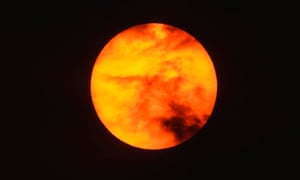The pattern of bushfires is part of our lives. But these fires are not going out
We
know the sight by heart: corrugated iron on a low pile of ash with a
chimney left standing. Another house gone. And the pattern of bushfires
is part of our lives too. They burn until a cold wind blows up the coast
when it buckets down dousing the flames.
But that’s not the pattern now. The downpour has been postponed officially until late January. Things are looking up: it was April. Either way the experts are saying the weeks ahead are looking dry, tinder dry.
As that news sank in this summer an unfamiliar emotion took hold in Australia: not fear so much as dread. These fires are not going out.
We know the language of fires. All our lives we’ve waited to hear a blaze is “under control”. Sweet words. But these days they come with a caveat: only for a few days until the wind shifts and the fire jumps the lines.
And the rain never comes.
We’re used to seeing the bush growing back quickly, green shoots
appearing within days on burnt trunks. Eucalypt forests have amazing
regenerative powers. But these fires are tearing through ancient forests that have never burnt before. They are done for. And the burnt gums are waiting for rain.But that’s not the pattern now. The downpour has been postponed officially until late January. Things are looking up: it was April. Either way the experts are saying the weeks ahead are looking dry, tinder dry.
As that news sank in this summer an unfamiliar emotion took hold in Australia: not fear so much as dread. These fires are not going out.
We know the language of fires. All our lives we’ve waited to hear a blaze is “under control”. Sweet words. But these days they come with a caveat: only for a few days until the wind shifts and the fire jumps the lines.
And the rain never comes.
We’re taught not to look at the sun. Every child on earth is given the same warning. But in Australia these days you can stare all you like. Take a good long look at that pink disc sinking in the murk. It can’t do you much harm. It’s been tamed by smoke.
The smoke is new too: cities suffocating. We’re used to a day or two in town when there’s a bit of smoke about and the light turns a horrible yellow. That’s every summer. But this is different. Deep in cities, miles from the fire front, the smoke is so thick you can’t see to the end of the street.
Yet we’ve never seen so much before. Everyone is a photographer now. And until the transmission towers burn and batteries flatten extraordinary images are making their way to the media. We’re seeing these horrors in all their detail.
On the beach at Mallacoota, families sat in the smoke under a sky of flame. It’s all on camera. The scene was repeated up and down the coast. At Malua Bay in New South Wales, children, their parents and grandparents were trapped for a day and night between fires and the sea. They’re safe now but it was a close call.
Already, these scenes are part of the national imagination. Among Australians of a certain age, they stir memories of a Hollywood potboiler about the end of the world filmed 60 years ago in Melbourne. On the Beach starred Ava Gardener, Gregory Peck and Fred Astaire. The remake stars us.
One of the duties of a leader is to find the words in times like these. So many have died. So much has been destroyed. But how can Scott Morrison speak to the experience of the country if he can’t admit we are living through unique times? He says instead: “We have faced these disasters before.”
Watch and act, Prime Minister. Watch and act.
If Morrison could face the truth, he might speak not only to his country but the world. If Australia were taking effective action against climate change, this catastrophe would give us the right to demand better of the great rogue states on climate, China and the USA.
We’re doing our bit, he says as the country burns and the world looks on with a mix of pity and scorn.
For empathy, we turn to the plain speech of fire chiefs as they count the toll, giving long lists day after day of destruction, bravery, death and lucky escape in the face of fires these men and women have never seen before.
And on television every night, with looks of professional apology, weathermen and women standing in front of scarlet maps of Australia tell us over and over again the news that makes sense of all these woes: according to the best forecasts, we have at least weeks to wait for rain.
- David Marr is a Guardian Australia journalist

No comments:
Post a Comment